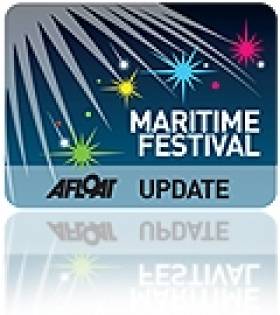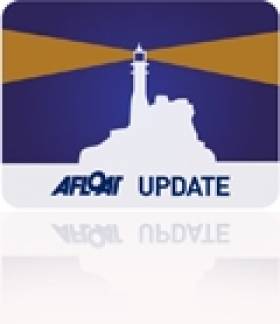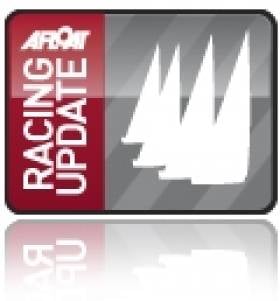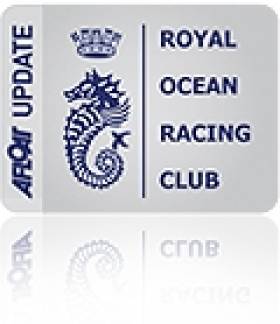Displaying items by tag: Cowes
Boat & Leisure Festival Scrubbed in Cowes
#MARITIME FESTIVALS – Organisers of the 2012 Boat & Leisure Festival 'Cowesfest' have taken the difficult decision to cancel the Jubilee-themed Festival that was scheduled to be held in Cowes Yacht Haven on Monday 4th and Tuesday 5th June.
Spearheaded by the Managing Director, James Brooke, his vision for this two-day Festival was to create a stunning display of British boats and outdoor leisure activities for visitors to see, interact with and enjoy in celebration of the Queen's Diamond Jubilee. Plans were also well underway to incorporate a packed schedule of live music. Sadly, it has not been possible to encourage enough companies to take exhibitor space and participate at the Festival, despite the low cost of doing so in such a high profile venue and over such a special bank holiday. However, Mr Brooke has been astounded by some terrific support shown particularly from local residents and some companies based on the Isle of Wight, and the organising team would like to express sincere thanks for this support.
"We feel that cancelling the Festival now is the responsible decision to take as it would be hugely disappointing for everyone if we produced an event that is anything less than exceptionally good. We pride ourselves on delivering high quality events, and hope that the time and effort that has been put into planning this event can be rewarded at a future date," says Mr Brooke.
He continues, "In order to help protect the future of other events and exhibitions, any companies wishing to exhibit at them really must understand that they will not be able to take advantage of any discounted or free stand space by waiting until the last minute to book! This notion simply undermines the potential success of the entire event and shows little consideration for all the other exhibitors who have been so supportive from an early stage. This culture has become widespread within the marine industry, and we consider it to be a greater threat to the future of exhibitions than the current economic climate."
Any deposits paid are being refunded in full.
Crosshaven Boatyard Appointed Seaward Agents
Crosshaven Boatyard Co. Ltd have recently signed a 'Representation Agreement' with top of the range motor boat builders Seaward Marine of Cowes on the Isle of Wight.
The Cork yard will act as Seaward Marine Ltd's exclusive representative for the promotion and marketing of their range of pleasure craft in Ireland.
Seaward Marine Ltd have a modern facility in Cowes and they are world renowned for their comprehensive range of Nelson motor yachts. Over the past 25 years TT Boat Designs, the Nelson designers, have produced a range of safe all-weather sea keeping craft. The luxury fit-out provided the all-important niche and reputation for Seaward craft that has continued to date.
The current range consists of the Seaward 23, 25 and 29, the Seaward 35 Cockpit and Aft-deck versions and the magnificent Nelson 42. All craft are semi-custom fitted and are offered with a choice of propulsion to suit every need.
For further information please contact Hugh Mockler or Donal McClement at Crosshaven Boatyard Co. Ltd,
Ireland Thankful to Escape Favourites Tag for Commodore's Cup 2012
Ireland's 2010 Commodore's Cup winning captain showed his relief at the news that Hong Kong have been tipped as favourites for next July's event, The Irish Times reports.
The announcement was made this week at the Royal Ocean Racing Club (RORC) in London, and should lift a burden off an Irish squad which has long suffered under the weight of being pre-event favourites.
Ireland's concerns instead have turned to whether a team can even be assembled for next summer's event in light of the difficult economic environment - and despite the RORC opening the rating bands to allow for more flexible combinations of boat sizes.
As previously reported on Afloat.ie, the Irish Cruiser Racing Association (ICRA) is seeking expressions of interest to form an Irish team and remains hopeful of mounting a serious defence of the title won by last year's Anthony O’Leary-captained squad.
The next Commodore's Cup - which also has a new title sponsor in Brewin Dolphin - takes place from 21 to 28 July 2012 in Cowes.
King One Gets off to Strong Start in Half Ton Cup
Ireland's only representative in the Half Ton Cup has opened his account with a third placing, David Cullen's King One from Howth Yacht Club was vying for the lead in the first race yesterday and with an early start this morning in a race around the Isle of Wight Cullen is again in the hunt in the offshore race that counts for double points.
For the 38 strong fleet assembled in Cowes for the 2011 Half Ton Classic Cup, supported by South Boats, today's opening three races were confirmation that the Half Ton Class continues to go from strength to strength. Throughout each of the day's three races the fleet was tightly packed with plenty of close quarters drama keeping both the sailors and the spectators on the edge of their seats.
The entry list represents a true cross section of the original Half Ton fleet with the oldest boat being the 1977 Davidson designed Waverider, owned by A Delvaus of Belgium, a double winner of the Half Ton Cup in 1978 and 1979 when skippered by Laurie Davidson himself. The newest boat in the fleet is the 1992 Caccerelli designed Per Elisa, owned by Britain's Robbie Tregear, which was the last of the grand prix Half Tonners ever built, launching in 1992.
Racing was initially postponed for two and a half hours whilst the fleet waited for wind but the wait was worth it with a nice 10-12 knots from 135 degrees filling in around lunchtime. The Race Committee, led by Race Officer Rob Lamb, was able to set up shop on the Hill Head Plateau and with judicious use of a relatively short windward leeward course they achieved three races that tested the teams to the full.
In the opening race Half Ton Class Chairman and defending champion Philippe Pilate's General Tapioca took an early lead on the water and on corrected time and despite the many attempts by Francois Michelin's Chani and Cullen's King One they held their lead through until the finish. On corrected time General Tapioca won by 34 seconds from Chani with King One taking third by just three seconds.
Race two went to Sibelius, owned by Jean-Philippe Cau who also took control of the race early on and then refused to relinquish their lead. Michael Kershaw's Chimp finished 57 seconds behind them with Tim and David Cunliffe's Insatiable three seconds behind that in third place. General Tapioca had to settle for fourth, just nine seconds behind Insatiable.
In race three General Tapioca came to the fore again, this time winning by ten seconds from Chimp with Denzil Williams' Santa Evita third and Robbie Tregear's Per Elisa fourth.
In the overall standings General Tapioca now leads the fleet by two points from Chimp who counts 8 points, with Sibelius third on 14 points, Chia fourth on 22 points and Insatiable fifth on 24 points.
The event also features a special division for Production Boats, which this year features two Hustler SJ30s, two MG HS 30s, a Golden Shamrock, an Albin Ballad, an X95 and a Hustler SJ32. Today's top performer in the Production Division was Francois Michelin's Golden Shamrock Chiani, which won the first two races and finished second in race three. Richard Hollis's X95 Crakajax now lies in second place thanks to a 3, 3, 1 score line with Frederic Denis' Fletcher Lynd, a Hustler SJ30 two points behind in third.
After racing Mike Relling, who is sailing aboard Insatiable with David and Tim Cunliffe, commented on the incredible quality of the racing. "It was very close and I think the good thing is that among the top ten boats there are only seconds between each place so mark roundings, boat handling, all of the little details are very, very important. I think that says a lot about the Half Ton Class, the success of the class and the success of IRC. The ratings seem to be pretty fair, and like any good regatta if you sail well you will do well, if you sail badly you will do badly and there's nowhere to hide. I think that makes it a fantastic event."
Today the fleet will be racing around the Isle of Wight. The start is scheduled for 07.30 from the Royal Corinthian Yacht Club start line off Cowes and the fleet will round the Island anti-clockwise. With a forecast for moderate to fresh winds, a double points weighting and a no discard on the score for the race we can anticipate another exciting day. The regatta continues until Friday 26 August with up to twelve races scheduled.
Record-Breaking Conditions Ahead for Fastnet Race
The largest, most diverse fleet of racing boats ever in offshore yachting set sail this morning in the Rolex Fastnet Race.
The biennial flagship event of the Royal Ocean Racing Club, a tradition since 1925, will take the fleet some 608 miles from Cowes on the Isle of Wight along the UK's south coast and across the Celtc Sea to Fastnet Rock off the Cork coastline, before returning past the Scilly Isles to the finish line at Plymouth.
An incredible 318 yachts are competing this year and they come in all shapes and sizes, from the 40m trimaran Maxi Banque Populaire to the 9.1m Rogers 30, Brightwork.
The majority of the fleet will be racing under the IRC for the Fastnet Challenge Cup, won by the crew that sails best to their rating. The weather will play a big part in this, as a fast start and slow finish favours bigger boats - so far today looks to be the opposite.
The 45-55 foot boats will surely provide the most competitive action, with past Fastnet winner Piet Vroon piloting his championship-leading Ker 46 Tonnere de Breskens towards another victory.
Fans of the Volvo Ocean Race will also be watching the race live tracker intently today, as this is one of the only times many of the competitors will line up together before the start of the round-the-world yachting challenge.
Regatta News has more on the story HERE.
Sebago Shoeboat is Catch of the Day at Cowes
The authentic hand sewn Sebago deckshoe brand dating back to 1946 has been entertaining the crowds at Cowes this week. The Cowes comeback has been dominated by the 'Sebago Shoeboat' cruising the Medina with gifts for home coming sailors. Sebago's 'Catch of the Day' T-shirts have also created a stir, this limited edition range is the ideal way to discounted offers at the new Cowes Store located within easy reach of Cowes Yacht Haven.
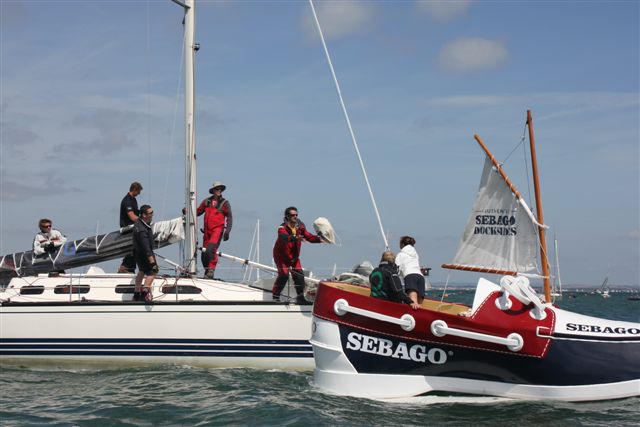
Sebago goodie bags are greatly received by home coming sailors on the Medina
As well as supplying some of the high profile race boats with their technical line, Sebago has come to the aid of the charity 'Toe in the Water'. This tri-service initiative aims to inspire men and women who have sustained traumatic injuries, including the loss of limbs, to move beyond their disability and to become re-inspired by life. Competitive sailing is a physically and mentally challenging adventurous sport and provides a unique opportunity for injured service personnel.
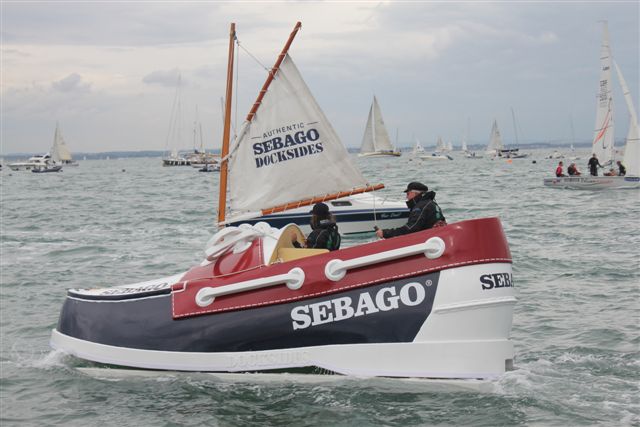
The Sebago Shoeboat cruising the Medina
Sebago has supplied all of the 'Toe in the Water' crews with performance footwear for men and women who have served their country. Lloyd Hamilton, Racing Director, Toe in the Water, commented:
"Having been loaned the Farr 45 by Tony Langley, one of the caveats for Cowes was that we only wear sailing shoes on board the race boat to keep it in the best condition. Sebago came to us in our hour of need supplying sailing shoes to our 4 crews. We have had certain situations where the grip technology has been utilised and it has never let us down!"
For over six decades Sebago has been igniting individuality in all product ranges inspired by their roots in the Magical states of New England, USA. All lines are ideal for life in or around the water, made for who people are and how they live. This much loved brand will be launching a new marine technical range during September 2011, further details to follow.
Adie Callaghan, Marketing Manager Northern Europe at Sebago, added:
"We have had a wonderful week with our lady Sebago Shoeboat flying the flag for the brand and hopefully providing a bit of humour for the competitors and spectators alike this year! We are also honoured to have been able to help the charity Toe in the Water, who do tremendous work for our injured service men and women."
Thousands Enjoy Champagne Sailing at Cowes
Winds in the morning were more moderate than yesterday, at 10-15 knots, but a short shower that passed over Cowes at lunchtime heralded a rapid strengthening of the breeze. The mean wind peaked just above 20 knots, but gusts again topped 30 for a couple of hours before the breeze moderated a little in the early afternoon.
The larger boats in the Black Group classes starting on the Royal Yacht Squadron line headed east, with wind and tide behind, so a cautious approach to the start was essential. As with other classes, the Contessa 32 fleet was quick to set spinnakers after the gun. Eldred Himsworth's Drumbeat led away from the line, a good two lengths ahead of three boats that were neck and neck with each other: Michael Hill's Nimbus, Chris North's Andaxi and Ray Rouse's Blanco.
Jess Hoggarth's Corafin started a little further back and well to leeward, but sailing higher and faster. Within two minutes of the start she was rivalling Nimbus, who had broken away from the others, at the front of the fleet. However, by the end of the four-hour race Corafin had slipped to fifth place, while Drumbeat took her first win. Simon and Kay Porter's Equator was second and Blanco, winner on the first two days, third.
Gybe mark action
IRC Class 6 was approaching a gybe mark at East Bramble when the wind started to increase. Jim Cullumbine's Maxi 1050 Merhaba led the fleet at the mark, 45 seconds ahead of Stephen James' Swan 38 Jacobite. Chris Haworth's Half Tonner Beat & Run was next, at head of a tightly-knit pack of six boats. Rory Fitzwilliams' Three-Quarter Tonner Simplicity caught a gust to storm past to windward of Beat & Run, while Andy King's 80-year-old 30 Square Metre Gluckauf whisked past to leeward.
It wasn't long before the stronger winds started to create problems. Tony Mace's Carter 39 Saphir, for instance, was unable to rig the pole on the new side after gybing, her flogging spinnaker a severe hindrance for James Verner and Lisa Anderson's much smaller Impala 28 Nyala trapped in her lee.
In the Quarter Ton class, 19 year old Mark Lees' Team Echo pushed the small boat hard all day to take their first win. On the long beat home against the tide from Gilkicker, Lees stayed in the tidal lee to the east of the Bramble bank for longer than rival, the Welch, Manser, Flemming and Fulford team, on Phoenix, who made an earlier break for the Island shore. "We didn't know who would be ahead until we tacked towards the Island shore," said Lees, "but in the end we crossed well ahead." Oli Ophaus, who was borrowing Louise Morton's Espada as his own boat Cote was dismasted in yesterday's strong winds, was third.
In Class IRC 0 Charles Dunstone's Team Origin took his first win of the regatta, beating another TP52, Franck Noel's Near Miss, by more than five minutes on corrected time. "It was one of those days when everything went right," said Team Origin navigator Mark Chisnell. "We made no mistakes, got the right side of the windshifts, and extended our lead round the course. We saw marginally higher windspeeds upwind than yesterday, but today's downwind legs weren't as furious and exciting."
White Group
The smaller day boats headed towards the north shore after starting in a westerly direction from the Royal Yacht Squadron line. This made a start at the outer end of the line, followed by a quick tack onto port being the favoured strategy.
In the Sunbeam fleet Julian Money's Penny and Roger Wickens' Danny had the best starts, with Danny marginally ahead and faster, but to leeward of Penny. Money tacked onto port later than the rest of the fleet, but held a useful advantage to windward of the pack as they headed across the Solent.
After two hours of racing the bulk of the Daring fleet was impressively tightly bunched – and mingled with J/80s – as they dropped spinnakers and turned upwind at their sixth mark, Hamble Yacht Services. The front runners of both classes, however, had pulled out significant leads: in the Darings Giles Peckham, Milo Carver & Richard Romer-Lee in Dauntless, and Jeremy Preston, Mark Fear and Scott Macleod's Defender.
For many White Group classes, the beat from here to Stormforce Coaching buoy, at the entrance to Southampton Water, was followed by a tight spinnaker reach to East Knoll, just as the wind was gusting to maximum strength. The leading SB3s were first round, with the top three boats – Mark Stokes' Eau No!, David Cummins's Rumbleflurg and the Oppie Dads' Sponge Bob – well spaced out and enjoying a comfortable margin ahead of the fourth-placed boat.
This leg proved a problem for many of the Darings, which broached repeatedly in spectacular fashion before almost everyone dropped spinnakers. The SB3s and J/80s, in contrast bore away on the gusts for a super-fast downwind blast, before dropping kite and luffing up for a quick white-sail reach into the mark.
At the Daring's finish, Dauntless and Defender retained first and second places respectively, while J & J Hackman, A Babbington-Smith and J Matthews' Double Knot took third. Henry Bomby's Team Baltic was first J/80, more than two minutes ahead of Ian Atkin's Boats.com, while William Goldsmith's Team Exess was third.
The 145 boats in the XOD class raced on a windward / leeward course in the shelter of the Isle of Wight to the east of Cowes. In such a big fleet consistency is the key to overall success, but only three boats have top 10 results in both the races sailed so far: Adrian Summers, Ian Paton and Ed Fitzgerarld's Excalibur added a fourth place to their existing seventh; William Norris' Beatrix scored seventh today following a ninth in the first race; and Karl Thorne and Caroline Driscoll's Mersa has notched up two 10th places.
Extreme Sailing Series at Aberdeen Asset Management Cowes Week
The talk of the day was a spectacular pitchpole by Aberdeen Asset Management, after the boat had scored a second place – her best result so far in the event. As the teams came ashore at the end of the third day of racing the overall standings were as follows:
1 Luna Rossa - 74 points
2 The Wave, Muscat - 68 points
3 Team GAC Pindar - 57 points
4 Groupe Edmond de Rothschild - 54 points
5 Red Bull Extreme Sailing - 52 points
6 Alinghi - 51 points
7 Oman Air - 46 points
8 Niceforyou - 35 points
9 Emirates Team New Zealand - 35 points
10 Aberdeen Asset Management - 31 points
11 Artemis Racing - 21 points
12 Team Extreme - 16 points
Report by Rupert Holmes
A collision occurred on Saturday at Aberdeen Asset Management Cowes Week between the Class 4 boat Atalanta and an incoming tanker. SEE VIDEO BELOW.
One member of the crew was knocked overboard and is OK. A further crew member has been injured and has been taken to hospital but later discharged. An official investigation on the incident has been launched.
{youtube}L5Nrx3Mdzls{/youtube}
The footage, now on youtube, was taken by Tim Addison, who was filming racing for cowes.co.uk, the website of the Cowes Harbour Commission.
A Maritime and Coastguard Agency (MCA) spokesman said: 'Two people were thrown overboard by the collision. The Marine Accident Investigation Branch and the MCA duty surveyor have been informed. The tanker continued to its destination at Fawley and the yacht has been towed to the UKSA berths at Cowes.'The Rhib (rigid-hulled inflatable boat) Vigilant took one of the crew back to shore for medical attention whilst the Southampton Patrol Boat and Hamble Rescue took the second crew member who had suffered a gash to his head to a waiting ambulance at Trinity Pontoon for transport to Newport Hospital. He was later reported to have been discharged.
Fickle Winds Prevail for RORC Channel Race
The leg to St Catherine's was painful and as the new breeze filled in from the South West it was those who were offshore that benefitted. There were several retirements but those that stuck it out were rewarded with some excellent sailing in a moderate breeze once they got to Bembridge Ledge.
The shy reach east to Saltdean Light Buoy (off Brighton) favoured the yachts carrying asymmetric spinnakers and by the time the fleet finished back in the Solent it was a glorious day with fair winds for a wonderful finale to the race.
David Aisher's J/109, Yeoman of Wight, crewed by the British Keelboat Academy were the overall winners in a large fleet taking the Channel Challenge Cup.
Yeoman of Wight's skipper, Henry Smith described the important factors in their win. "We got through Hurst in good shape. Leading our class, because we decided to go to the main land shore, which worked very well for us. Like the rest of the fleet, when the wind died we ended up kedging at Bridge.
However for most of the race we had a spinnaker up and we were very meticulous about our watch system, making sure that we all stayed as fresh as possible, especially alternating trimmers and minimising disruption during hand overs by talking through the conditions as new crew came up on deck. We approached Saltdean Light Buoy with favourable tide and as we went around the tide turned in our favour and we knew we were in with a chance. It was a great team effort and we are absolutely delighted with our win."
" I am very proud of their achievement" commented David Aisher. "The average age of the team is just twenty one, and this is a great boost to their confidence before the Rolex Fastnet Race, which is just a few weeks away."
In IRC Zero, Johnny Vincent's TP 52, Pace, scored a notable victory over IRC Zero RORC Season's Points Leader Venomous, skippered by Derek Saunders and Andres Soriano's Mills 68, Alegre.
In IRC One, Mark Devereux's Swan 42, Brevity, claimed their first class win of the season beating the current RORC Season's Points Championship leader Piet Vroon's Tonnerre de Breskens. Jonathan Goring's Ker 40, Keronimo, was third in class.
IRC Two produced a titanic battle between two J/122s, Neil Kipling's Joopster, and Alain Catherineau's Lorelei. Joopster won class by just under three minutes on corrected time. Quokka 8, sailed by Sailing Logic, took line honours for the class and was just five minutes short of eclipsing the winner after time correction.
IRC Three was won by Yeoman of Wight, second was Tor McLaren's J/109, Inspara, with Peter Olden's A 35, Solan Goose of Hamble, third.
IRC Four saw a clean sweep of podium places for French yachts. Nicolas de la Fourniere's X-34, Exile/Mirabaud, was first in both IRC Four and the Two-Handed Class. Frederic Waniart's Aphrodite 101, Vim, and Pierre Viard's Prism 28, Adrenaline, were second and third in IRC Four, respectively.
"What a difference a day makes" commented RORC Racing Manager, Ian Loffhagen. "Before the start drizzle and the fickle wind was not conducive to great racing but as forecast the breeze did fill in and those yachts that stuck it out enjoyed a great race in some beautiful conditions. The race took most of the yachts about 24 hours as planned and more importantly, fulfilled several yachts ambitions of completing the necessary qualifying miles for the Rolex Fastnet Race. I am sure that the competitors and also all of us at the RORC are now fully focused on the highlight of the season."
The Rolex Fastnet Race starts on August 14th, competitors are advised that decals, trackers and Sailing Instructions are now available from the RORC Office in Cowes, however these will only be issued to yachts that have completed all of the entry requirements.
Antix Finishes Second at British IRC Championships
Royal Cork's Antix skippered by Anthony O'Leary has finished as runner up in the IRC 1 division at a heavy weather staging of the British IRC Championships this afternoon.
With eight bullets in eight races, Peter Rutter and the crew of the Grand Soleil 43, Quokka 8, comfortably secured the 2011 IRC National Championship title as well as victory within IRC 2.
"I am incredibly proud - my crew have really worked their hearts off," said Rutter. "I have never been able to win this regatta before and I said to them 'we have to nail it this time' and they have worked their cotton socks off. So I am very very pleased and it is nice to have got this one finally put away. The boat is going well, the sails are good and the crew work has been stunning."
Matters were made no easier for the crew after Quokka 8's skipper unwisely chose light and moderate weather kites for this regatta, which has typically seen the wind rarely drop below 20 knots. Rutter paid his respects to the RORC race committee for laying on a good series, also admitted that being one of the fastest boats in Class 2 also helped. "It was the place to be, in winds of this strength - it helped you get clear wind. But keeping the boat under the rig was the important thing in this regatta!"
One of the favourites in IRC1, Jonathan Goring's new Ker 40, Keronimo, put this to the test today when on the final run of the second and final race, she was nailed by a squall, causing her to re-enact the famous pitchpole of Silk II (as captured on camera by Beken of Cowes). Tactician Simon Shaw recounted what occurred: "A big black cloud was chasing us down the run and we'd just changed on to the no4 and gybed to come into the mark when the front of the gust hit and the wind went from 26 to pretty much 40 knots...
"The boat instantly jumped into the wave we were following. The rudder was fully out of the water. It was a bit like watching one of those Extreme 40 capsizes - you are on top of the world looking down at the boat, holding on to the runners with your legs dangling down into the cockpit going 'hang on I thought this only happened on catamarans!'"
Keronimo teetered in her pitchpoled position for what seemed like 10 seconds, her bow buried so deeply into the water that the instrument displays on her mast were submerged, until eventually the fitting at the end of her bowsprit exploded and the chute roared aft destroying all the stanchions along her starboard side. "We lost one guy off each side and one off the bow," continued Shaw. "So we scooped everyone back in, wrestled the chute down over the back, pulled the jib up, bore away and carried on with the race." Thankfully no one was hurt in the incident.
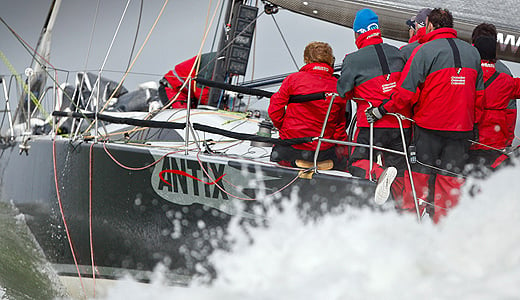
Royal Cork's Antix finished second in Cowes this afternoon. Photo: Paul Wyeth
Victory in the hard fought IRC 1 was deservedly scooped up by the winner of both today's two races, Piet Vroon's Ker 46 Tonnerre de Breskens 3, also winner of the Jackdaw Trophy for coming second overall under IRC. Anthony O'Leary's Antix finished just a point adrift in second in IRC 1, ahead of third placed Keronimo.
Another equally unusual incident occurred prior to the start of today's first race on board Peter Morton's MAT 1010, one of the contenders in IRC 3, when her port cabintop window imploded. The exact reasons for this remain a mystery. but Morton believes the window was weakened by a barber hauler block repeatedly rapping against it and broken terminally when the weight of one of the crew was applied to it. In the brisk conditions they were forced to retire.
In IRC3 today's winner, claiming both races, was Michael Brough's Bavaria Match 38 Steady Barker, but even this fine show left them three points adrift of Mike Bridges' Elan 37, Elaine, the class victor.
Brough, who has been toughing it out since he twisted his knee during racing yesterday, says Steady Barker enjoys light or heavy airs and in this regatta they have seen more than their fair share of the latter.
Their racing today was also not without incident. "Before the start of the second race our mainsail ripped luff to leech," said Brough. "We just got it down, put some duck tape over it and it managed to make it all the way." Fortunately when the squall hit on the last race they were sailing upwind and the most they saw was 32 knots. Even so they decided to play it safe on the final run and chose not to hoist the kite. "We thought we'd see if anyone blinked before we put the kite up," admitted Brough. "Fatjax tried it and went over on her side. Even so we were doing 10.5-11 knots without the kite."
IRC 4 saw Adam Gosling's Corby 30 Yes! claim two bullets to win their class overall, albeit just three points ahead of Michael Kershaw's Half Tonner, Chimp.
Generally of this RORC IRC Nationals Brough observed: "The races have been great. Everyone is absolutely shattered on the boat, including the bowman. It has been hard racing and I'm glad RORC stuck with it rather than just canning it."



























